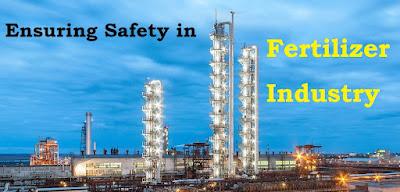Ensuring Safety in the
Fertilizer Industry
TOWER, CRAWLER CRANE - PICTORIAL CHECKLIST
The
fertilizer industry plays a critical role in the global food supply, but it
also presents a number of safety hazards for workers. These hazards include
exposure to toxic chemicals, the risk of explosions and fires, and the
potential for injury from heavy machinery and equipment. To ensure the safety
of workers in the fertilizer industry, it is important to understand and comply
with the various safety requirements that apply to this industry.
One of the
key safety requirements in the fertilizer industry is the handling and storage
of hazardous chemicals. Many fertilizers contain toxic chemicals that can be
harmful if not handled properly. To protect workers from exposure to these
chemicals, employers must implement proper handling and storage procedures, as
well as provide personal protective equipment (PPE) such as gloves, goggles,
and respirators. Employers should also conduct regular training on chemical
hazards and emergency procedures to ensure that workers are aware of the risks
and know how to respond in the event of an emergency.
Another
important safety requirement in the fertilizer industry is the maintenance and
inspection of equipment and machinery. Fertilizer manufacturing and
distribution facilities rely heavily on heavy machinery and equipment, such as
conveyor belts, cranes, and forklifts. To prevent accidents and injuries,
employers must ensure that all equipment is properly maintained and inspected
on a regular basis. Additionally, they should provide training on the safe use
of equipment and machinery, and establish clear procedures for reporting and
addressing equipment malfunctions.
HOT WORK PERMIT TO WORK ( PTW )TEMPLATE SAMPLE
The risk of
explosions and fires is also a significant safety concern in the fertilizer
industry. Fertilizer dust and gases can easily accumulate and create a fire or
explosion hazard. To prevent these incidents, employers must implement proper
housekeeping and ventilation practices, and conduct regular inspections to
identify and address potential hazards. They should also establish emergency
evacuation plans and conduct regular drills to ensure that workers know how to
respond in the event of a fire or explosion.
Other important safety requirements in the fertilizer industry include:
Compliance
with OSHA regulations and standards
Properly
labeling and handling of hazardous waste and materials
Implementing
a process safety management program
Regularly
inspecting buildings, structures and equipment for safety
Conducting
regular safety audits and incident investigations
Maintaining
a safe working environment in the fertilizer industry requires a combination of
proper training, equipment maintenance, and compliance with regulations.
Employers in this industry must take a proactive approach to identifying and
addressing potential hazards, and must ensure that all workers are aware of the
risks and know how to respond in the event of an emergency. By implementing
effective safety programs, employers can help to reduce the risk of accidents
and injuries, and improve the overall safety of their workplace.
Part 3 - Construction Safety Pictorial Guidelines
"Ensuring
Safety in the Fertilizer Industry: Meeting Requirements for Hazardous
Chemicals, Equipment and Machinery, and Emergency Preparedness"
"Navigating
Safety in the Fertilizer Industry: Compliance with Regulations, Managing
Hazards, and Improving Employee Training"
"Safe
Fertilizer Production: Adhering to Standards for Hazardous Chemicals, Equipment
Maintenance and Emergency Preparedness"
"Fertilizer
Industry Safety: Addressing Chemical Hazards, Machinery Safety, and Emergency
Preparedness"
"Meeting
Safety Standards in the Fertilizer Industry: Managing Hazardous Chemicals,
Equipment and Emergencies"
Fertilizer
industry, safety requirements, hazardous chemicals, explosions and fires,
equipment and machinery, OSHA regulations, process safety management,
housekeeping and ventilation, emergency evacuation, hazardous waste and
materials, safety audits and incident investigations, employee training.
SAFETY TRAINING | AWARENESS VIDEOS IN HINDI





No comments:
Post a Comment